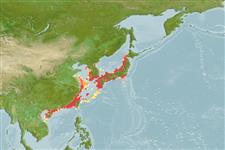分類 / Names
共通名の | 類義語 | Catalog of Fishes(部類, 種) | ITIS | CoL | WoRMS | Cloffa
>
Tetraodontiformes (Puffers and filefishes) >
Tetraodontidae (Puffers) > Tetraodontinae
Etymology: Takifugu: A Japanese word with several meanings; taki = waterfall + fugu = fish; it could be also understood as taki = to be cooked in liquid + fugu = a venomous fish.
More on authors: Jordan & Snyder.
Environment: milieu / climate zone / depth range / distribution range
生態学
海 底生の. Temperate
Northwest Pacific: Japan and southern Korea to Vietnam (Ref. 46893).
サイズ / 重さ / 年齢
Maturity: Lm ? range ? - ? cm
Max length : 15.9 cm TL オス/雌雄の選別がない; (Ref. 125279); 最大公表体重: 83.30 g (Ref. 125279)
During high tide, mature individuals swim ashore in large numbers and spawn on beaches. Eggs are left partially buried in sand and rubble (Ref. 240).
Life cycle and mating behavior
成熟 | 繁殖 | 放精 | 卵 | 生産力 | 幼生
During high tide, mature individuals swim ashore in large numbers and spawn on beaches. Females spawn on the surface with two or more males biting and hanging on to the ventral surface of each female. Eggs are left partially buried in sand and rubble (Ref. 240).
Masuda, H., K. Amaoka, C. Araga, T. Uyeno and T. Yoshino, 1984. The fishes of the Japanese Archipelago. Vol. 1. Tokai University Press, Tokyo, Japan. 437 p. (text). (Ref. 559)
IUCNのレッドリストの状況は (Ref. 130435: Version 2024-2)
人間に対する脅威
Poisonous to eat (Ref. 9137)
Human uses
水産業: 潜在的興味の
用具
特記事項
XMLをダウンロードして下さい
インターネットの情報源
Estimates based on models
Preferred temperature (Ref.
123201): 17.1 - 26.6, mean 23.6 °C (based on 116 cells).
Phylogenetic diversity index (Ref.
82804): PD
50 = 0.5000 [Uniqueness, from 0.5 = low to 2.0 = high].
Bayesian length-weight: a=0.01862 (0.01461 - 0.02374), b=2.91 (2.84 - 2.98), in cm total length, based on LWR estimates for this species (Ref.
93245).
栄養段階 (Ref.
69278): 3.3 ±0.44 se; based on food items.
回復力 (Ref.
120179): 高い, 15か月以下の倍増期間の最小個体群 (Preliminary K or Fecundity.).
Fishing Vulnerability (Ref.
59153): Low vulnerability (10 of 100).
